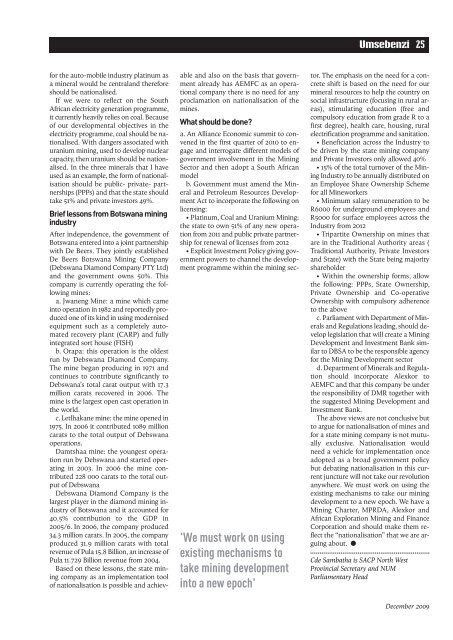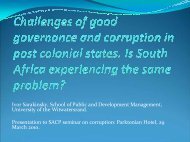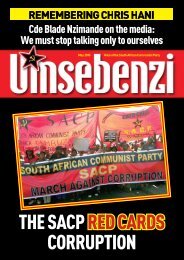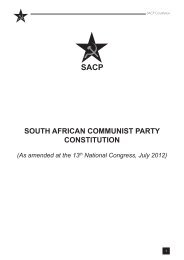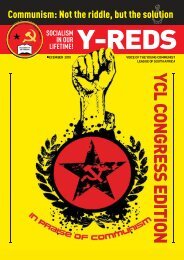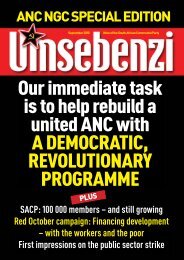Forward to Socialism!! - South African Communist Party
Forward to Socialism!! - South African Communist Party
Forward to Socialism!! - South African Communist Party
Create successful ePaper yourself
Turn your PDF publications into a flip-book with our unique Google optimized e-Paper software.
Umsebenzi 25<br />
for the au<strong>to</strong>-mobile industry platinum as<br />
a mineral would be centraland therefore<br />
should be nationalised.<br />
If we were <strong>to</strong> reflect on the <strong>South</strong><br />
<strong>African</strong> electricity generation programme,<br />
it currently heavily relies on coal. Because<br />
of our developmental objectives in the<br />
electricity programme, coal should be nationalised.<br />
With dangers associated with<br />
uranium mining, used <strong>to</strong> develop nuclear<br />
capacity, then uranium should be nationalised.<br />
In the three minerals that I have<br />
used as an example, the form of nationalisation<br />
should be public- private- partnerships<br />
(PPPs) and that the state should<br />
take 51% and private inves<strong>to</strong>rs 49%.<br />
Brief lessons from Botswana mining<br />
industry<br />
After independence, the government of<br />
Botswana entered in<strong>to</strong> a joint partnership<br />
with De Beers. They jointly established<br />
De Beers Botswana Mining Company<br />
(Debswana Diamond Company PTY Ltd)<br />
and the government owns 50%. This<br />
company is currently operating the following<br />
mines:<br />
a. Jwaneng Mine: a mine which came<br />
in<strong>to</strong> operation in 1982 and reportedly produced<br />
one of its kind in using modernised<br />
equipment such as a completely au<strong>to</strong>mated<br />
recovery plant (CARP) and fully<br />
integrated sort house (FISH)<br />
b. Orapa: this operation is the oldest<br />
run by Debswana Diamond Company.<br />
The mine began producing in 1971 and<br />
continues <strong>to</strong> contribute significantly <strong>to</strong><br />
Debswana’s <strong>to</strong>tal carat output with 17.3<br />
million carats recovered in 2006. The<br />
mine is the largest open cast operation in<br />
the world.<br />
c. Letlhakane mine: the mine opened in<br />
1975. In 2006 it contributed 1089 million<br />
carats <strong>to</strong> the <strong>to</strong>tal output of Debswana<br />
operations.<br />
Damtshaa mine: the youngest operation<br />
run by Debswana and started operating<br />
in 2003. In 2006 the mine contributed<br />
228 000 carats <strong>to</strong> the <strong>to</strong>tal output<br />
of Debswana<br />
Debswana Diamond Company is the<br />
largest player in the diamond mining industry<br />
of Botswana and it accounted for<br />
40.5% contribution <strong>to</strong> the GDP in<br />
2005/6. In 2006, the company produced<br />
34.3 million carats. In 2005, the company<br />
produced 31.9 million carats with <strong>to</strong>tal<br />
revenue of Pula 15.8 Billion, an increase of<br />
Pula 11.729 Billion revenue from 2004.<br />
Based on these lessons, the state mining<br />
company as an implementation <strong>to</strong>ol<br />
of nationalisation is possible and achiev-<br />
able and also on the basis that government<br />
already has AEMFC as an operational<br />
company there is no need for any<br />
proclamation on nationalisation of the<br />
mines.<br />
'We must work on using<br />
existing mechanisms <strong>to</strong><br />
take mining development<br />
in<strong>to</strong> a new epoch'<br />
What should be done?<br />
a. An Alliance Economic summit <strong>to</strong> convened<br />
in the first quarter of 2010 <strong>to</strong> engage<br />
and interrogate different models of<br />
government involvement in the Mining<br />
Sec<strong>to</strong>r and then adopt a <strong>South</strong> <strong>African</strong><br />
model<br />
b. Government must amend the Mineral<br />
and Petroleum Resources Development<br />
Act <strong>to</strong> incorporate the following on<br />
licensing:<br />
• Platinum, Coal and Uranium Mining:<br />
the state <strong>to</strong> own 51% of any new operation<br />
from 2011 and public private partnership<br />
for renewal of licenses from 2012<br />
• Explicit Investment Policy giving government<br />
powers <strong>to</strong> channel the development<br />
programme within the mining sec<strong>to</strong>r.<br />
The emphasis on the need for a concrete<br />
shift is based on the need for our<br />
mineral resources <strong>to</strong> help the country on<br />
social infrastructure (focusing in rural areas),<br />
stimulating education (free and<br />
compulsory education from grade R <strong>to</strong> a<br />
first degree), health care, housing, rural<br />
electrification programme and sanitation.<br />
• Beneficiation across the Industry <strong>to</strong><br />
be driven by the state mining company<br />
and Private Inves<strong>to</strong>rs only allowed 40%<br />
• 15% of the <strong>to</strong>tal turnover of the Mining<br />
Industry <strong>to</strong> be annually distributed on<br />
an Employee Share Ownership Scheme<br />
for all Mineworkers<br />
• Minimum salary remuneration <strong>to</strong> be<br />
R6000 for underground employees and<br />
R5000 for surface employees across the<br />
Industry from 2012<br />
• Tripartite Ownership on mines that<br />
are in the Traditional Authority areas (<br />
Traditional Authority, Private Inves<strong>to</strong>rs<br />
and State) with the State being majority<br />
shareholder<br />
• Within the ownership forms, allow<br />
the following: PPPs, State Ownership,<br />
Private Ownership and Co-operative<br />
Ownership with compulsory adherence<br />
<strong>to</strong> the above<br />
c. Parliament with Department of Minerals<br />
and Regulations leading, should develop<br />
legislation that will create a Mining<br />
Development and Investment Bank similar<br />
<strong>to</strong> DBSA <strong>to</strong> be the responsible agency<br />
for the Mining Development sec<strong>to</strong>r<br />
d. Department of Minerals and Regulation<br />
should incorporate Alexkor <strong>to</strong><br />
AEMFC and that this company be under<br />
the responsibility of DMR <strong>to</strong>gether with<br />
the suggested Mining Development and<br />
Investment Bank.<br />
The above views are not conclusive but<br />
<strong>to</strong> argue for nationalisation of mines and<br />
for a state mining company is not mutually<br />
exclusive. Nationalisation would<br />
need a vehicle for implementation once<br />
adopted as a broad government policy<br />
but debating nationalisation in this current<br />
juncture will not take our revolution<br />
anywhere. We must work on using the<br />
existing mechanisms <strong>to</strong> take our mining<br />
development <strong>to</strong> a new epoch. We have a<br />
Mining Charter, MPRDA, Alexkor and<br />
<strong>African</strong> Exploration Mining and Finance<br />
Corporation and should make them reflect<br />
the “nationalisation” that we are arguing<br />
about.<br />
Cde Sambatha is SACP North West<br />
Provincial Secretary and NUM<br />
Parliamentary Head<br />
December 2009


